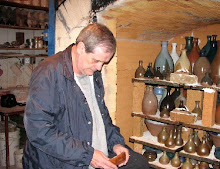Floating Blue
Floating Blue (also called Blue Hare's Fur) is probably the most well known and popular cone 6 pottery glaze. It was popularized by the book The Potter's Complete Book of Clay and Glazes by James Chappell (in the current edition it is on page 210 under the heading "Floating Glazes"). The author calls it "spectacular and extraordinary". In fact, the vase that graces the cover of the book uses this glaze. Like most other popular glossy GB base glazes, this one also uses nepheline syenite, silica and kaolin. Its borate content is about middle-of-the-road compared to the range of recipes that we have studied. Like the Butterscotch glaze, the fired effects produced by this recipe are a testament to the variegating effects that 4% rutile imparts to colored non-opacified boron glazes.
The term 'floating' could refer to two possibilities in our observation: The blue cobalt colored surface appears to float on a translucent brown glass layer. This layer is visible where the color breaks to brownish hues on thinner sections at edges and irregularities in the surface. More likely, however, it refers to a white opalescent 'boron-blue' layer that often appears to float over the cobalt blue background (boron-blue calcium borate crystals form in borate glazes when calcium is present and the glaze is very fluid). This effect can best be amplified by melting a ball of glaze on a tile to get a very thick pool of glass. Cappell says "the colors seem to float on a surface of a darker background of great depth, reminiscent of a deep pool of water".
An amazing thing about this recipe is that it actually has the potential to produce six separate mechanisms of variegation:
· Its color and opacity vary greatly with thickness so it highlights irregularities in the surface.
· 'Phase separation' in the translucent matrix makes the color 'swirl' as small rivulets of more fluid glass flow around more viscous phases.
· Titanium crystals in the matrix make it sparkle.
· Calcium-borate boron-blue crystals grow on the surface.
· Bubbles of escaping gases create pools of lighter colored glass surrounded by darker rings.
· Small black speckles are produced by unground particles of iron.
No wonder this is such a popular glaze among potters!
Anyone who has used this glaze will testify to the fact that it is "fickle" as Chappell notes. He makes a number of recommendations on using this recipe:
-use distilled or low mineral water,
-force all material through an 80 mesh screen,
-stir thoroughly before and during use to prevent settling out of the iron content,
-apply the thickness of a dime (1mm.),
-fire to cone 6 oxidation exactly, and cool normally.
A-Here are a few examples for cone 6 oxidation :
Floating Blue
Nepheline Syenite, 47.3
Gerstley Borate, 27.0
Silica, 20.3
Kaolin, 5.4
Totals, 100.0
Rutile, 4.0
Red Iron Oxide, 2.0
Cobalt Oxide, 1.0
from James Chappell
Floating Blue#1
Nepheline Syenite, 41
Gerstley Borate, 17
Ferro Frit #3134, 13
Silica, 18
Kaolin, 11
Totals, 100
Rutile, 4
Red Iron Oxide, 2
Cobalt Carbonate, 1.5
From Clayart (Ron Roy)
Floating Blue#2
Nepheline Syenite, 35.5
Gerstley Borate, 8.5
Ferro Frit #3134, 24.5
Silica, 16
Kaolin, 15.5
Totals, 100
Rutile, 4
Red Iron Oxide, 4
Cobalt Carbonate, 1.5
From Clayart (Ron Roy)
Floating Blue#3
Nepheline Syenite, 30
Ferro Frit #3134, 36
Silica, 14
Kaolin, 20
Totals, 100
Rutile, 4
Red Iron Oxide, 2
Cobalt Carbonate, 1.5
From Clayart (Ron Roy)
B-One example for cone 10 oxidation :
Floating Blue
Potassium Spar, 52.0
Gerstley Borate, 11.5
Wollastonite, 9.0
Kaolin, 5.5
Silica, 22.0
Totals, 100
Rutile, 4.0
Red Iron Oxide, 2.0
Cobalt Oxide, 1.0
From Clayart (Tom Buck)
C-A few examples for cone 9-10 reduction :
Floating Blue #1 C9R
Cornwall Stone, 27
Potassium Spar, 16
Ferro Frit #3134, 18
Dolomite, 4
Silica, 18.5
Whiting, 6
Ball clay, 9
Kaolin, 8
Totals, 106.5
Bentonite, 2
*QIT-UGS, 4
*QIT-Ilmenite, 2
Cobalt carbonate, 0.5
This is a modified version of Ron Roy’s Coyote Blue
published on Clayart (newsgroup).
Floating Blue #2 C9R
Cornwall Stone, 63.8
Gerstley Borate, 14.3
Silica, 7.6
Whiting, 7.6
Kaolin, 4.8
Zinc Oxid (calc.), 1.9
Total, 100
Bentonite, 2
*QIT-UGS, 4.2
*QIT-Ilmenite, 2.0
Cobalt carbonate, 0.5
This is a modified version of Wayne Conrad’s Moonlight Blue
published on Clayart (newsgroup).
References :
1-Digitalfire.com, Tony Hansen, Alberta, Canada
http://digitalfire.com/
2-The Potter’s Complete Book of Clay and Glazes, James Chappell.
3-Clayart, a newsgroup for ceramicists.
http://lsv.ceramics.org/archivedata/clayart.html
*QIT-Fer et Titane, a subsidiary of Rio Tinto Zinc (United Kingdom),
operates a huge ilmenite mine in northeastern Québec.
The ore is shipped to their Sorel-Tracy facilities where it is processed to
many products among which ilmenite and UGS.
UGS is a granular synthetic rutile and the particle size used varied
from from 120 to 140 mesh.
jeudi 10 mai 2007
Inscription à :
Publier les commentaires (Atom)

Aucun commentaire:
Enregistrer un commentaire